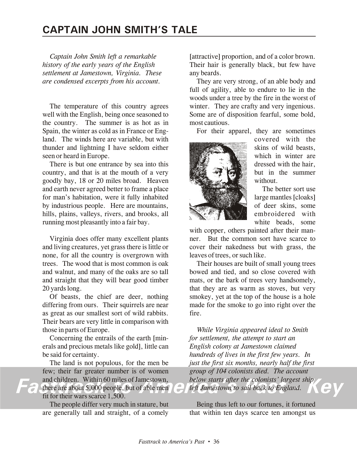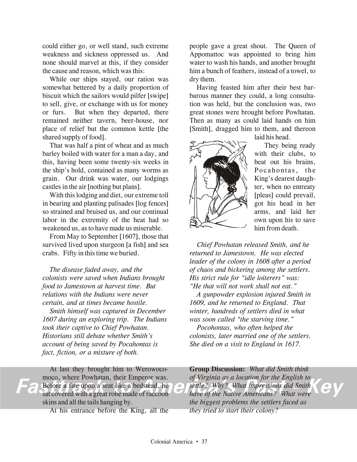| Fasttrack
to America's Past Teacher Key |
|
| Fasttrack
to America's Past Teacher Key |
|
 Page 36  Page 37 |
Pages 36
& 37 - Captain John Smith's Tale The reading selection Before reading this selection, be sure
students are familiar
with the basic facts about John Smith and Jamestown. Remind students that John Smith did not
marry Pocahontas.
They were great friends, but Pocahontas was only about 12 when
Jamestown
was first settled. In 1609 Smith returned to England after being
burned badly in a gunpowder explosion, and Pocahontas thought Smith had
died. She later married another colonist, John Rolf. When
they
visited England, Pocahontas was overjoyed to find Smith was alive, and
met him once again. Sadly, Pocahontas died soon after, as she and her
husband
were preparing to return to Virginia. There are, however, many
descendants of their family living in Virginia even today. Historians are not all agreed about the section in which Smith tells how he was saved from death by Pocahontas. Many say that the event was actually an initiation ceremony of some sort, and point out that Smith was known for exaggeration. Others, however, believe the story is probably true as it is presented. The pictures The picture on page 36 is one of the best known images of Captain John Smith. His leadership saved the colony from disaster in the first two years, but a gunpowder burn forced him to return to England. His later written accounts are a valuable source of information about early English exploration and Native American life. The picture on page 37 is a modern drawing that imagines what Pocahontas may have looked like in 1607, when she first visited the Jamestown colony. She ranks as one of the most remarkable women of her time because of the way she bridged the cultures of Native Americans and Europeans.
Smith writes in glowing terms to praise
Virginia as an
ideal place for the English to settle. Although the climate and
weather
runs to extremes wider than England, he writes, "Heaven and Earth never
agreed better to frame a place for man's habitation..." He does not, however, consider the Indians very industrious, at least in the way Europeans like himself defined that term. While respecting the Indians and admiring many of their qualities, he obviously believes the land of Virginia would be greatly improved if were settled by Englishmen. The problems faced by the original settlers at Jamestown were many, but the reading makes it clear that a deadly disease was by far the worst. Smith writes that supplies were short from the beginning, and became even more scarce after the colonists' largest ship left to return to England. The colonists had to build shelter and a palisade of logs for protection, all heavy work in weather that was much hotter than the English were used to. Smith notes the "extreme weakness and sickness" that struck the group. Jamestown is marshy, and no doubt had the usual summer mosquitos. Smith does not name any specific disease, but its effects were certainly deadly. Fifty colonists, he says, died from May to September. |
|
Copyright Notice
Copyright 2018 by David Burns. All rights reserved. Illustrations and reading selections appearing in this work are taken from sources in the public domain and from private collections used by permission. Sources include: the Dover Pictorial Archive, the Library of Congress, The National Archives, The Hart Publishing Co., Corel Corporation and its licensors, Nova Development Corporation and its licensors, and others. Maps were created or adapted by the author using reference maps from the United States Geological Survey and Cartesia Software. Please see the home page for this title for more information. |